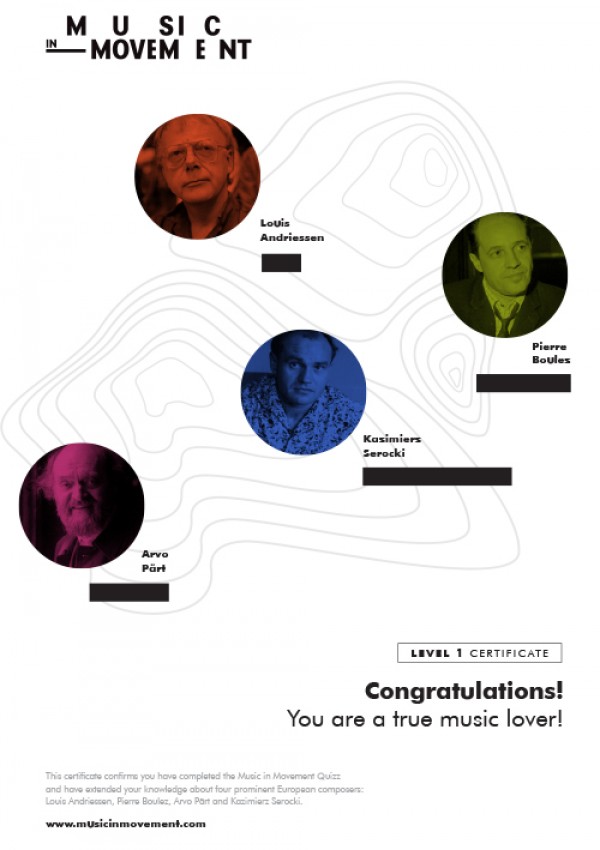MiM quiz – Expert level / Education
Remember, this quiz is not about testing your knowledge about contemporary music. It's all about getting to know the four composers - their music, techniques, but also inspirations and private stories. We invite you to take on this challenge - discover the universe of four personalities and dive in into their music.
In which example is the sound of instruments transformed electronically?
Choose one or more:
Pierre Boulez – …explosante-fixe… for MIDI flute, two flutes, ensemble and electronics (1991–93).
Louis Andriessen – De Tijd for choir and orchestra (1980–81). Louis Andriessen sometimes used electronics, but the sophisticated colours and effects in the piece are achieved without electronics.
Kazimierz Serocki – Pianophonie for piano with electronic transformation of sound and orchestra (1979).
Arvo Pärt – Miserere (1989–92). Arvo Pärt did not use electronics, the reverberation is, of course, entirely natural.
Creative periods - Pierre Boulez
Which work by the composer is earlier? Which is later?
The earlier one should be indicated.
Discreet use of live electronics (delay, reverb diversification) points to a later period of Pierre Boulez creations, associated with the IRCAM technology (Dialogue de l'ombre double, 1985). In the case of Le marteau sans maître (1954), the earlier date is indicated, inter alia, by the melody characteristic for the avant-garde of the 50s.
Inspirations from outside European classical music were important to each of the four composers
The task is to link the source of inspiration to the right name.
Although elements of Polish folklore found their way into Kazimierz Serocki’s music only for a few years and to some extent were associated with a need for a compromise with the ideology of Stalinist Poland, the artistic results of these inspirations are still worthy of note.
Louis Andriessen’s creative imagination was under the influence of jazz from his early youth.
Although generally Pierre Boulez was far from imitating folk music or music of other cultures, the sound of non-European instruments, like those in the Indonesian gamelan, often attracted him more than the conventional sound of classic European ensembles and orchestras.
The term “tintinnabuli”, which Arvo Pärt uses to describe his own style and technique denotes “little bells” (Lat.).
Which ones among the four composers created such ensembles?
Many contemporary composers were also performers of their own (and not only their own) music; some even founded ensembles specialising in performances of contemporary works (not only their own).
In 1976 Pierre Boulez founded Ensemble Intercontemporain – an ensemble of 31 soloists specializing in new music, which became a model for similar enterprises in France and other countries. Louis Andriessen sought to create a new type of ensembles, providing an alternative to the line-ups and modes of operation of conventional orchestras and chamber ensembles – he put his concepts into practice in Orkest de Volharding and Hoketus, which he co-founded.
Composers and trends of music of the recent and distant past had a considerable influence on all four composers. Link a source of inspiration to a composer.
The affinity between Stravinsky’s and Louis Andriessen’s music is evidenced not only by the Dutch composer’s works but also by a book devoted to the Russian’s oeuvre which Louis Andriessen co-authored (The Apollonian Clockwork).
The impact of Bartók’s music can easily be discerned in Kazimierz Serocki’s oeuvre of the first half of the 1950s, for example, in his Sonata for piano.
To a large extent the style and techniques Arvo Pärt developed in the late 1960s and early 1970s were a result of his studies of Renaissance and late medieval polyphony, and Gregorian chant.
The avant-garde of the 1950s, including Pierre Boulez, considered the music of Anton Webern to be its predecessor and model to be developed further.
Well done!
We hope you enjoyed the experience!
You can now share & save your MiM certificate!

